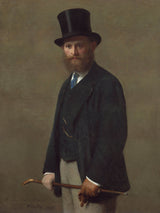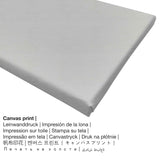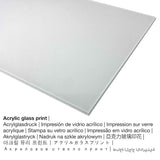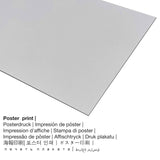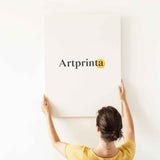Henri Fantin-Latour, 1867 - Édouard Manet - mbipụta nka mara mma
Ụtụ gụnyere. Mbupu gbakọrọ na ndenye ọpụpụ.
Onyinye ngwaahịa ebipụta
The 19th narị afọ ihe omimi Edouard Manet e kere onye nwe n'ezie Henri Fantin-Latour. Nke mbụ nwere nha 46 1/4 × 35 7/16 na (117,5 × 90 cm) e were kwa ihe-ọcha tee ya mmanụ na kwaaji. Ihe osise a nwere ederede dị ka ndetu: inscribed lower left: A mon Ami Manet. / Fantin. 1867.. Enwere ike ilele ihe nka a na mkpokọta nka Ụlọ ọrụ Art Chicago in Chicago, Illinois, United States of America. We are happy to state that the public domain artwork is being supplied with courtesy of Ụlọ ọrụ Art Chicago. : Stickney Fund. Besides, the alignment of the digital reproduction is in Eserese format with a side ratio of 3 : 4, which means that the length is 25% shorter than the width. The painter, graphic artist, botanical illustrator, lithographer Henri Fantin-Latour was an artist, whose art style can primarily be classified as Realism. The French painter was born in 1836 na Grenoble, Auvergne-Rhone-Alpes, France wee nwụọ mgbe ọ dị afọ 68 N'afọ 1904 na Basse-Normandie, France.
Họrọ ngwa ngwaahịa ọkacha mmasị gị
Anyị na-enye ihe dị iche iche dị iche iche na nha maka ngwaahịa ọ bụla. Nha na ihe ndị a bụ nhọrọ anyị na-enye gị maka nkeonwe:
- Mbipụta akwụkwọ mmado (akwa akwa akwa): The poster print is a UV printed canvas with a slightly roughened structure on the surface. Please bear in mind, that depending on the size of the poster we add a white margin of something between 2-6 cm round about the painting, which facilitates the framing.
- Bipụta na enyo acrylic: A glossy print on acrylic glass, which is sometimes described as a UV print on plexiglass, will convert the original artwork into wonderful home décor. The major advantage of a plexiglass print is that contrasts and also granular details will be more visible thanks to the fine gradation of the print.
- Aluminom ihe eji eme ihe: Aluminium Dibond prints are prints on metal with an impressive depth effect, which creates a contemporary look with a non-reflective surface structure. For your Print On Aluminum Dibond, we print the selected work of art right onto the surface of the aluminum material. The colors of the print are luminous, details are very clear, and the print has a a matte look you can literally feel.
- Kwaaji: The printed canvas, which should not be mistaken with a painting on a canvas, is a digital replica printed directly on canvas. The canvas print makes a familiar, positive atmosphere. Hanging your canvas print: Canvas prints are relatively low in weight, which means that it is quite simple to hang your Canvas print without any wall-mounts. A canvas print is suited for any type of wall.
Ederede iwu dị mkpa: We try our best in order to describe our art products as closely as possible and to exhibit them visually on the different product detail pages. Please bear in mind that the tone of the print products and the printing can diverge slightly from the presentation on your monitor. Depending on the settings of your screen and the quality of the surface, colors might not be printed one hundret percent realistically. Because all are processed and printed by hand, there may as well be slight deviations in the size and exact position of the motif.
Banyere edemede a
| Bipụta ụdị ngwaahịa: | ezi nka mmeputakwa |
| Mmeputakwa: | mmeputakwa n'ụdị dijitalụ |
| Usoro nhazi: | mbipụta dijitalụ (Mbipụta UV ozugbo) |
| Ihe ngosi: | emere na Germany |
| Ụdị ngwaahịa: | a na-achọ |
| Ojiji ngwaahịa: | mgbidi mgbidi, ihe ndozi ụlọ |
| Nhazi nke ihe nka: | nhazi ihe osise |
| Oke akụkụ: | 3: 4 ogologo ruo obosara |
| Ntụgharị nkọwa akụkụ onyonyo: | ogologo bụ 25% mkpụmkpụ karịa obosara |
| Nhọrọ ihe dị: | Mbipụta kwaaji, mbipụta enyo acrylic (nwere ezigbo mkpuchi iko), mbipụta akwụkwọ mmado (akwụkwọ kwaaji), mbipụta ọla (aluminium dibbond) |
| Kanvas n'elu etiti ihe ndọtị (mbipụta akwa akwa): | 30x40cm - 12x16", 60x80cm - 24x31", 90x120cm - 35x47", 120x160cm - 47x63" |
| Mbipụta iko acrylic (nwere ezigbo mkpuchi iko) dị iche iche: | 30x40cm - 12x16", 60x80cm - 24x31", 90x120cm - 35x47", 120x160cm - 47x63" |
| Nhọrọ nha nke akwụkwọ mmado (akwụkwọ kwaaji): | 30x40cm - 12x16", 60x80cm - 24x31", 90x120cm - 35x47" |
| Mbipụta aluminom (aluminium dibond ihe) dị iche iche: | 30x40cm - 12x16", 60x80cm - 24x31", 90x120cm - 35x47" |
| Nhazi mbipụta nka: | adịghị |
Data ndabere gbasara nka nka izizi
| Aha eserese: | "Édouard Manet" |
| Nhazi nka nka: | sere |
| Category: | nkà nke oge a |
| Century: | 19th narị afọ |
| Emepụtara na: | 1867 |
| Ogologo afọ nka nka: | ihe dị ka afọ 150 |
| Agba na: | mmanụ na kwaaji |
| Nha izizi: | 46 1/4 × 35 7/16 na (117,5 × 90 cm) |
| Akara mbinye aka: | inscribed lower left: A mon Ami Manet. / Fantin. 1867. |
| Ụlọ ihe ngosi nka / mkpokọta: | Ụlọ ọrụ Art Chicago |
| Ebe ngosi nka: | Chicago, Illinois, Njikota Obodo Amerika |
| Dị n'okpuru: | www.artic.edu |
| Akwụkwọ ikike nka: | ngalaba ọha |
| Site n'aka: | Ụlọ ọrụ Art Chicago |
| Ebe E Si Nweta: | Ụgwọ nke ụlọ ọrụ Stickney Fund |
Ozi nka ahaziri
| Aha onye nka: | Henri Fantin-Latour |
| Aha utu aha: | H. Fantin Latour, h.j.t.f. latour, Fantin, Fantin Latour, Fantin-Latour Ignace Henri Jean Theodore, Fantin-Latour Ignace-Henri Jean Theodore, h.j.t. fantin latour, Fantin-Latour Henri, fantin latour henri, fantin latour h.j.t., פנטין לאטור אנרי, Ignace Henri J. Th. Fantin-Latour, latour fantin, J. Th. fantin-latour, Ignace Henri Jean Theodore Fantin-Latour, Fantin-Latour Ignace-Henri-Jean-Théodore, Fantin-Latour Ignace Henri, Henri-Théodore Fantin-Latour, Henri Fantin-Latour, latour henri fantin, fantin latour henri, Fantin-Latour Henri-Théodore, I. H. J. Th. Fantin-Latour, Fantin-Latour, Latour Henri Fantin-, Fantin-Latour J.-H., H. Fantin-Latour |
| Gender: | nwoke |
| Obodo onye nka: | French |
| Ọrụ nke onye na-ese ihe: | painter, botanical illustrator, graphic artist, lithographer |
| Mba onye si: | France |
| Nkewa onye nka: | omenkà nke oge a |
| Ụdị nke onye na-ese ihe: | Ihe ngosi |
| Oge ndu: | 68 afọ |
| A mụrụ: | 1836 |
| Ebe omuma: | Grenoble, Auvergne-Rhone-Alpes, France |
| Afọ nwụrụ: | 1904 |
| Nwuru na (ebe): | Basse-Normandie, France |
© nwebisiinka, www.artprinta.com (Artprinta)
Ozi mgbakwunye sitere na ihe ngosi nka (© - Art Institute Chicago - www.artic.edu)
Édouard Manet was at the peak of his notoriety when the young Henri Fantin-Latour exhibited this portrait at the Salon of 1867. Manet himself chose not to submit any work that year, having had his submission rejected by the 1866 Salon jury. In this commanding image of the great French artist, Fantin portrayed Manet not as a painter, but as a flaneur, a sophisticated man-about-town whose eyes are open to every nuance of modern life. The background of the painting is almost completely blank, both in homage to works by Manet and in emulation of photographic portraits of the period.

